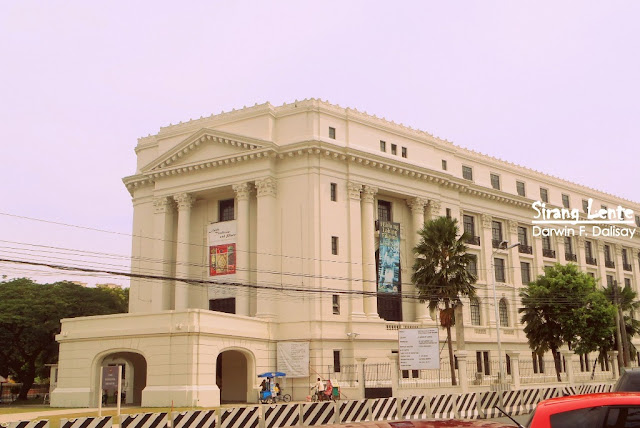
About the National Museum
Located in Rizal Park, Manila, the National Museum of the Filipino People—now known as the National Museum of Anthropology—houses invaluable artifacts that tell the story of the Philippines’ rich cultural heritage. From pre-colonial treasures to ethnographic collections, it offers visitors a deeper understanding of the nation’s diverse history and identity.
History of the Building

The edifice, which now forms part of the National Museum complex, was formerly referred to as the Finance Building, which had previously been occupied by the Department of Finance. It was built in 1940 and is principally credited to the architect Antonio Toledo. Toledo was with the Bureau of Public Works, the agency tasked with constructing Manila’s government structures under the American Colonial regime. In setting up its structures, the Bureau was influenced by the city plan devised around 1906 by Daniel Burnham. Courtesy: Philippine National Museum
See What's Inside
I have been dreaming of visiting the Philippine National Museum since high school, but in 2015, that dream came into reality as they offered free admission for the whole month of October. I traveled from the Marikina Shoe Museum to Manila to see what's inside.

San Diego Shipwreck Artifacts
Discover treasures and relics recovered from the 17th-century galleon San Diego, offering a glimpse into the Philippines’ maritime history.
Pre-Colonial Gold and Jewelry
Marvel at intricately crafted ornaments and ceremonial pieces that showcase the artistry of early Filipinos.
Ethnographic Collections
Explore traditional clothing, tools, and cultural artifacts from various indigenous groups across the Philippines.

Archaeological Finds
See ancient burial jars, pottery, and stone tools that provide insights into early Philippine civilizations.
Exhibits on Philippine Anthropology
Learn about the diverse cultures, traditions, and practices that continue to shape Filipino identity today.
Photos of Artifacts








The Manunggul Jar was discovered in the Neolithic burial site in Manunggul Cave of Tabon, Lipuun Point, Palawan. It was used as a coffin in a primitive way of burial in the Philippines.

Wooden coffins were discovered in one of the caves in Banton, Romblon.

The oldest Burial cloth found in Banton, Romblon.


The Philippine National Museum also has items from the south; like the Sarimanok and Kulintang. Even in this generation, these musical instruments are still part of their cultural presentations, events and festival.

One of the highlights of the building is the Baybayin, or the ancient and traditional scripts of the Philippines. A lot of artifacts, like books and jars, were displayed for reference. I am now planning to visit the 3,000-year-old petroglyphs located in Angono, Rizal.

The Philippines is composed of more than 7,000 islands, and with that factor, this country bears not only the heritage and historical sites but also archeological factors like these preserved butterflies, bugs, and other animals - proof that we have everything.

I was inside the Philippine National Museum for more than three hours. The whole time I was there, my mind was amazed by the artifacts, photos, and history, just like the staircases and the building walls (photo above). This year, in the same month, I'll make sure to visit this huge museum to see the discoveries.
How to Get to the National Museum
Public Transporation
- From MRT or LRT-2: Take the MRT or LRT-2 and transfer to LRT Line 1. Get off at UN Avenue Station, then walk about 10–15 minutes toward Rizal Park. The museum is located along Padre Burgos Avenue, near the National Museum of Fine Arts.
- From Quiapo or Intramuros: Jeepneys and UV Express vans passing through Padre Burgos Avenue can drop you near Rizal Park. From there, it’s just a short walk to the museum.
By Private Car:
Use Waze or Google Maps, pin the National Museum of Anthropology (Filipino People). Paid parking spaces are available around Rizal Park and along Padre Burgos Avenue.
Opening Hours and Admission Fees
Opening Hours:
The National Museum of the Filipino People is open Tuesday to Sunday, 9:00 AM – 6:00 PM. It is closed on Mondays and during national holidays.
Admission Fees:
- FREE admission for all visitors, both local and foreign.
- Special guided tours may be arranged for groups (check in advance with the museum).
Summary
A visit to the National Museum of the Filipino People is more than a journey through galleries—it is an exploration of who we are as a nation. With its wealth of artifacts and cultural exhibits, the museum continues to inspire pride, knowledge, and appreciation of the Filipino identity.
As someone who has visited all 82 provinces in the Philippines, I’ve created a complete guide to help you explore each one. Check out my Philippines 82 Provinces Travel Guide here.

No comments:
Post a Comment
Enter Comment Below: